Table of Contents
Electronic health records and electronic medical record systems are the foundation of the healthcare industry. Both clinical and administrative processes rely on EHR applications and EMR systems. With healthcare practices utilizing multiple solutions for clinical and administrative operations, EHR/EMR integrations can ensure a seamless flow of clinical data, manage communication and handle coordination between systems. EMR systems digitally store patient treatment records, charts, test results, and other patient data for simple access, management, and retrieval.
By making detailed patient history easily available whenever any healthcare provider demands it, EMR applications enable the continuity of care. Increasing patient outcomes minimizes charting errors and paperwork expenditures and enhances practice operations.
Today’s users expect a greater emphasis on EMR improvement in 2023. Organizations are looking to their technology partners to help relieve the pressure on the workforce as they struggle with staffing difficulties. This includes customizing the EMR or EHR applications to fit them effortlessly into their daily routines and assisting customers in availing advantages of underutilized technology such as surveillance-based toolkits and patient portals.
In 2023, users can expect greater capabilities from EHR and EMR applications for specialty clinics, telehealth solutions, remote patient monitoring systems, and more. In short, integrating EHR and EMR applications is a must-have now.
Why are EHR/EMR Integrations so Important to Healthcare Practices?

Integration entails enabling healthcare organizations to increase care quality and staff efficiency through data sharing between various EHRs, clinical systems, and applications from third parties. Moreover, integration facilitates access to services, decreases hospitalization and readmissions, and enhances treatment and patient satisfaction. Scalable and adaptive integration technologies are becoming differentiators in healthcare delivery as patient EHR and EMR data grow. In addition, if you are a healthcare firm trying to automate secure health operations, combining EHR and EMR applications with HIPAA-compliant systems/tools would fundamentally revolutionize your practice.
Some of the common benefits of integrating EHR and EMR systems are-
- Increased cost savings
- Improved communication and coordination between providers
- Improved efficiency
- Better patient care outcomes
- Increased patient satisfaction
- Real-time access to data and analytics
- Minimized data entry
Electronic medical record system integration is in high demand among healthcare firms today. Given the need for remote patient monitoring, chronic disease management, or data accessibility, integration of EHR applications and EMR systems have a proven track record of proficiency. Be it any specialty, software solution, or care practice, integrating EMR applications will only make them better.
Types of Integrations of EMR/EHR Applications
1. Telemedicine Software
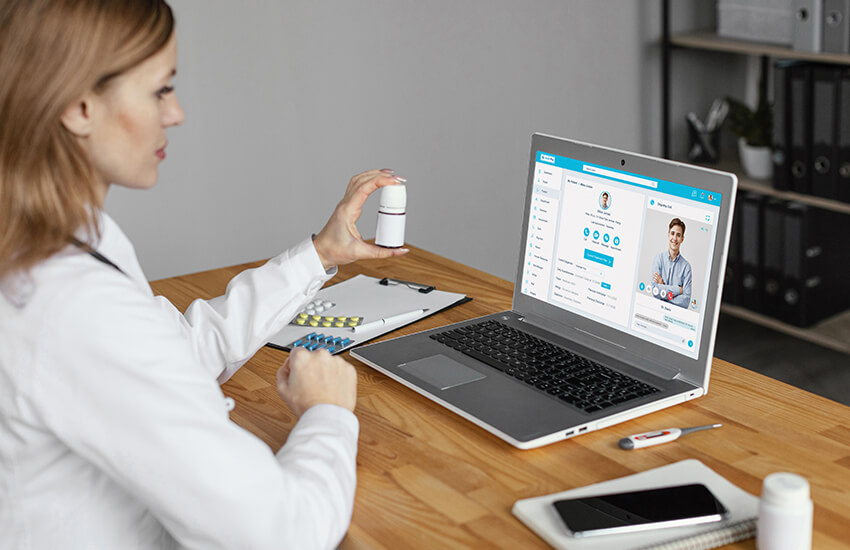
Healthcare delivery has shifted from in-person office visits to virtual visits and remote patient monitoring in recent years. The EMR software is a one-stop shop for care coordination, medical data storage, and progress tracking for most healthcare professionals. And EMR or EHR applications integrated with telemedicine software can transform the way of care delivery and handling patient records. Typically, there are two components to remember regarding EMR integration in telehealth applications. First, the bi-directional interface uses two-way communication in EMR and telehealth applications for smooth data flow. And the second is, of course, EMR. Medical history diagnosis, immunizations, medications, and more are all digitized.
While deciding whether to deploy the telehealth care delivery model, health systems consider whether telemedicine will make care more seamless or complex. EMR integration is an important factor to consider because it enhances provider efficiency and quality of service. When the EMR and telehealth or telemedicine software are connected, they communicate through a bidirectional workflow. It allows physicians to interact with a single platform rather than repeating work on two or more systems. This improves provider efficiency while empowering doctors to make evidence-based decisions, enabling speedier diagnosis, decreased prescribing errors, and improved patient outcomes. EMR integration connects several telemedicine applications and patient data.
Further, integrating telemedicine software with an EMR reduces record and process duplication. When a virtual visit happens, or remote monitoring devices gather biometric data, it automatically integrates into the EMR. And speeds up record collection and ensures all patient data is aggregated in one location. This improved procedure enables doctors to see more patients throughout the day without overburdening their office-visit scheduling, resulting in increased income for the company. All in all, EMR integration in telehealth software provides healthcare practitioners and facilities with multiple benefits. Some of them are-

A. Automated data entry: The integration of telehealth and EMR/EHR system removes the need for double data entry. When clinicians take notes during a telehealth appointment, the information is instantly entered into the patient’s health record, making data entry easier.
B. Advanced Clinical Workflow: Healthcare providers will continue considering the hybrid telehealth model even after the pandemic, in which patients benefit from in-person and virtual encounters. With EMR and telehealth integration, managing clinical workflows, such as administrative chores, appointment booking, notices, answering questions, and so on, can become more straightforward.
C. Patient Insurance Data in Sync: EMR-integrated telehealth systems can easily assess a patient’s health and other insurance eligibility details before scheduling a virtual telemedicine consultation. This ensures that providers are reimbursed for their experience and services, reducing workplace misunderstanding and costs.
D. Streamline virtual care experience: Integrating telehealth software’s EHR system gives doctors simple access to the patient’s health records. And they use the same way they are already familiar with, ensuring a smooth, seamless virtual experience.
2. Laboratory Information Systems

It is no secret that laboratories today face rising problems in an increasingly digital healthcare environment, ranging from regulatory changes and lower reimbursements to time and resource limitations. Succeeding in a data-driven and patient-centered care ecosystem, laboratories require new techniques and solutions to improve processes while allowing them to preserve profitability. With the rapid adoption of electronic medical record systems over the last few years, nearly all practices now not only enter their patients’ demographics, insurance information, billing formation, and clinical data into their EHRs, but they also expect to be able to order lab tests and receive lab results directly from within their system. Laboratory connectivity is expected for convenience and to meet standards for meaningful usage.
EMR and EHR integration with a Laboratory Information System (LIS) avoids challenges associated with receiving error-prone and time-consuming lab orders. The procedure is streamlined, and the lab process moves smoothly from order generation to receiving. Besides, this technology also allows practitioners to capture and process lab results swiftly. And this eliminates the possibility of error and allows a seamless flow of data and faster diagnosis. Code and billing validation processes are also simplified. The EMR and EHR integration in LIS can transform workflows and outcomes.
Here are some guaranteed benefits of EMR-integrated LIS.
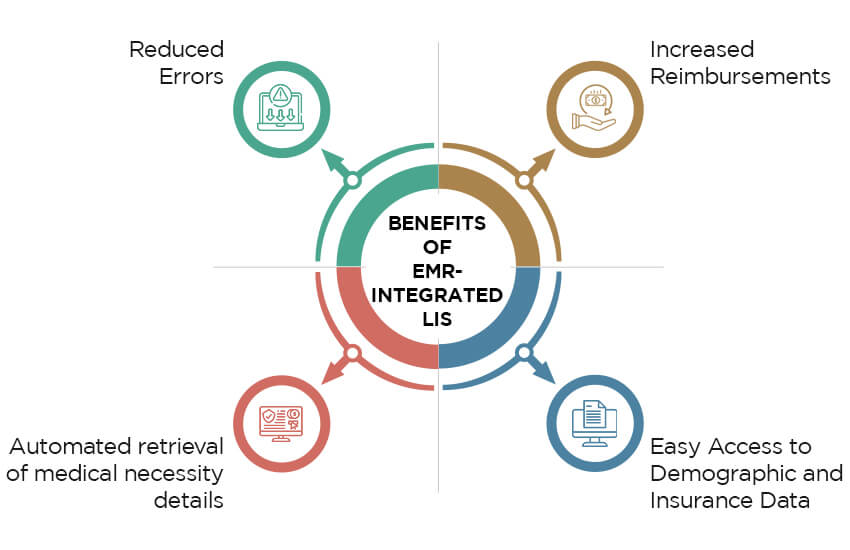
A. Reduced Errors: An EMR-integrated LIS can dramatically reduce errors in the lab testing process. An integrated system electronically transfers test findings to the EMR, eliminating the need for manually entering test data. This decreases the possibility of transcription errors. Also, it ensures accurate and speedy test results. An integrated LIS can also automate the flagging of aberrant test results, reducing the possibility of missing a crucial result.
B. Increased Reimbursements: LIS integrated with EMR can assist healthcare organizations in increasing payments. Test results are automatically uploaded to the EMR in an integrated system, which speeds up the billing procedure. This shortens the time required to bill for services provided and may result in faster payment cycles. Furthermore, an integrated system can lower the amount of refused claims owing to missing or incomplete information, improving overall revenue for the business.
C. Easy Access to Demographic and Insurance Data: Healthcare practitioners can readily access patient demographic and insurance information using an EMR-integrated LIS. This information is essential for accurate patient identification, and an integrated system can ensure that all data is updated and correct. This improves patient care and speeds up the billing process by shortening the time it takes to assess and verify insurance information.
D. Automated retrieval of medical necessity details: When a doctor or nurse orders a laboratory test, the EMR-integrated LIS can automatically check the patient’s insurance information to see if the procedure requires prior authorization. If prior authorization is required, the system can automatically request approval from the insurance provider company. The system can also automatically retrieve information about the test’s medical needs, which can help ensure that it is ordered only when medically essential. Further, the integrated system also ensures that the clinical documentation is included to emphasize the necessity of the lab tests.
3. Medical Device Integration
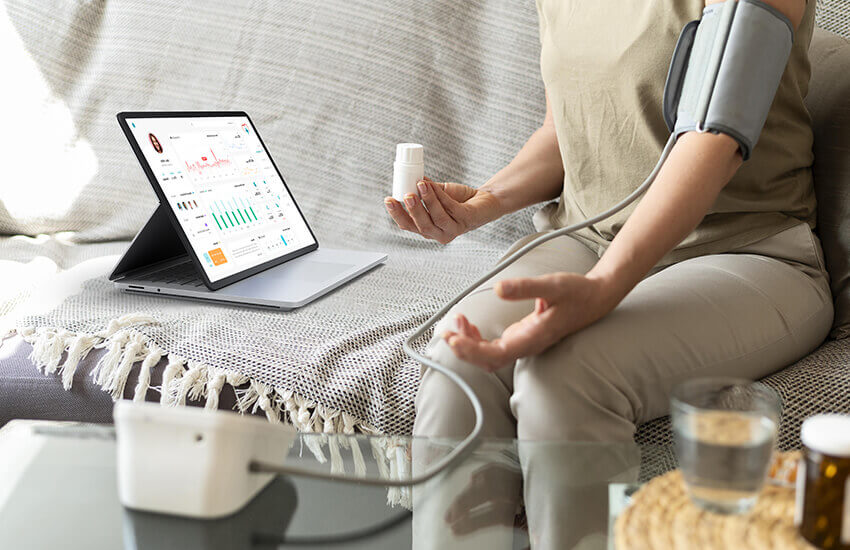
Many biomedical devices are used at the point of care in many practices today. Monitors, smart beds, anesthesia carts, finger cuffs, and ventilators are used in operating rooms and intensive care units to monitor vital signs such as blood pressure, heart rate, and oxygen saturation. And these devices generate massive amounts of data, which are used in clinical decision-making and regulatory compliance. However, manually transferring this data to EMR or EHR applications is tiresome for providers. The Medical Devices Integration (MDI) solution is a vendor-neutral software-based solution that wirelessly collects and integrates patients’ vital signs data generated by various medical devices into the Electronic Medical Records system.
Integrating electronic medical records and mobile devices reduces the time healthcare providers take to record manually and input readings into the EMR system. MDI increases user efficiency and productivity by effortlessly transmitting data from monitoring devices to the EMR system. This solution can also improve the accuracy and timeliness of patient information in the EMR. Take, for example- Before taking the patient’s vital signs, nurses identify and confirm the right patient by scanning the barcode on the patient’s wristband. Before approving the record in the MDI, the nurses verify the patient’s name and identification number (NRIC) and the other relevant readings. The MDI solution includes barcode scanning and validation tests to ensure the completeness and quality of patient vital sign readings before they are interfaced directly with the correct patient records in the EMR. This data is transferred from various medical devices to the EMR system.
Here are the key benefits of integrating electronic medical records and mobile devices.
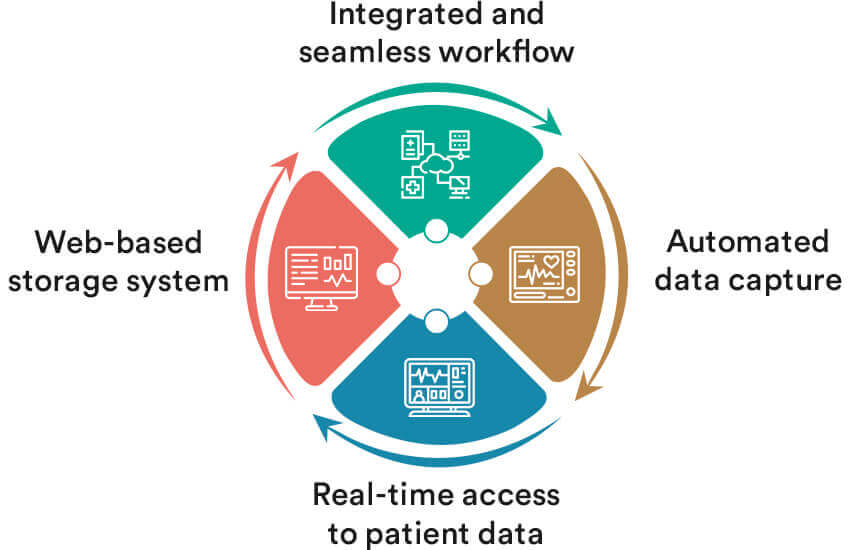
A. Integrated and seamless workflow: Medical device integration provides the hospital with an effective, simple, and understandable workflow. All the hospital’s departments are linked, and they can be readily handled owing to the web based EMR system.
B. Automated data capture: Eliminating manual labor by entering health records and clinical data is another contribution that makes the medical staff’s daily routine easier. As previously said, there is no longer a need to collect data manually because EMR-integrated medical equipment can collect and evaluate data automatically. As a result, medical workers can get clear and analyzed information, which will most likely be collected and summed up from multiple devices simultaneously. With integrated medical data, the process moves faster, boosting quality and eliminating all potential errors caused by human factors.
C. Real-time access to patient data: Another advantage of an EMR-integrated medical device is that doctors can monitor each patient’s health even if they are not physically present at the hospital. Also, patients can access information about their health, which includes doctors’ conclusions, analysis results, and medical prescriptions, without visiting the hospital. That is possible because of cloud-based online information access in real-time and the personal cabinet.
D. Web-based storage system: The data acquired from all medical devices will now be processed, saved, and safeguarded online. This means that there will be no more hunting for the required patients’ data across all devices, as the system will collect everything automatically and transfer the data directly to the storage location that is EMR or EHR systems. Furthermore, by utilizing such a method, data will stay well-protected and crack-proof.
4. Ophthalmology
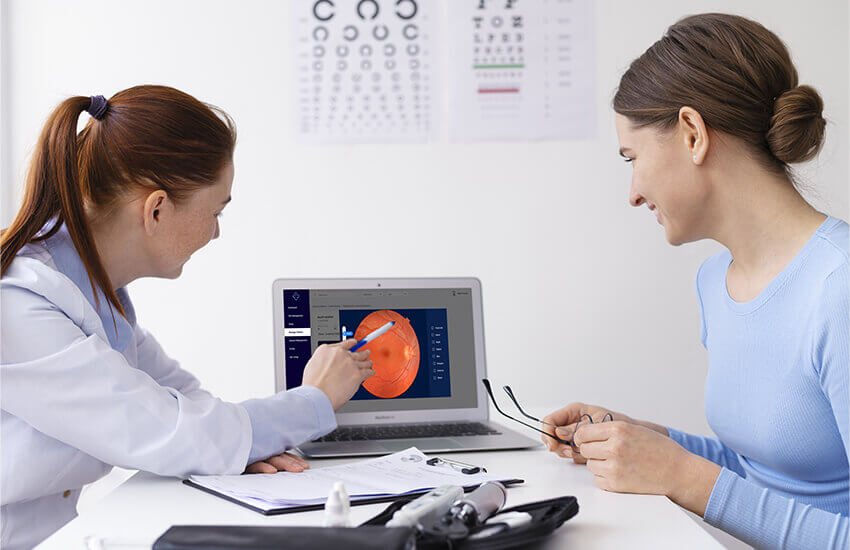
The workflow of ophthalmology practices includes features that other specialties only sometimes examine. The EHR and EMR systems must support what ophthalmology practices do daily, from co-managing patients to handling two sets of diagnosis codes and arranging procedures. Integrating electronic medical records for ophthalmology can provide outstanding drawing support to help clinicians capture patient data more efficiently. It securely links to numerous diagnostic software and devices for smooth clinical workflow. Clinicians can use this to retrieve patient information and perform external eye examinations, slit lamp examinations, fundus examinations, vision tests, and eye diagnostics. Further, EMR can be linked to devices like OCT, fundus cameras, scanners, and other tools.
The primary benefits of integrating electronic health records in ophthalmology practice are:
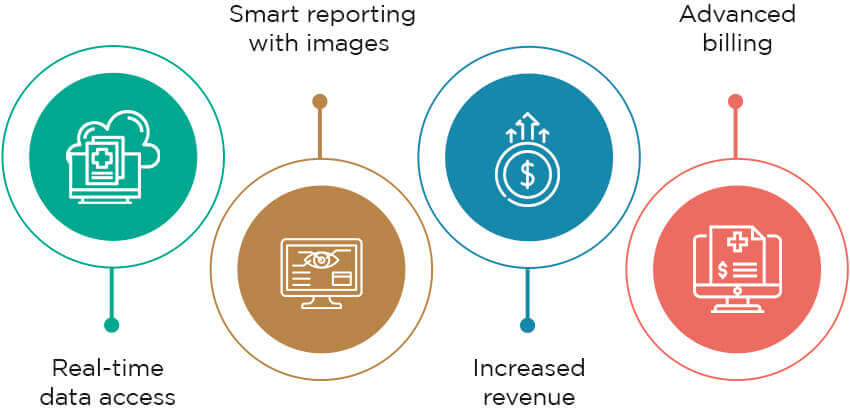
1. Real-time data access: Ophthalmology software integrated with EMR is a centralized healthcare cloud solution for eye clinic systems, doctors, administrative people, and other employees that offer them real-time access to data and allow them to make the best judgments possible.
2. Smart reporting with images: To increase the quality of time spent with patients, ophthalmology software integrated with EHR and EMR can provide a fast summary of the patient’s treatment progress and health data. You can see the patient’s medical history, eye examination, test results, treatment plans, crucial vitals, and investigations on a single screen. Besides, eye clinics can also offer their patients a paperless experience and more satisfaction.
3. Increased revenue: Hundreds of skilled staff are required to keep eye clinics or ophthalmology departments in hospitals functioning properly or to execute various functions and activities manually. Yet, if additional human resources entail more expenses in your clinic, you will have to spend more money in the long run. But, with the assistance of intelligent ophthalmic software integrated with an electronic health records system or a patient portal EMR, the facility can drastically cut workforce strength. Moreover, as the optometry software handles all operations, providers can only require a few people with manual administration.
4. Advanced billing: By improving the billing process and decreasing errors, EMR-integrated ophthalmology software can ensure advanced billing. The solution can ensure that all billable services and procedures are correctly captured and submitted for payment by using automatic charge capture. Moreover, by ensuring patient eligibility and coverage before services are given, real-time insurance verification functionality in the ophthalmology EMR software can prevent billing problems. Moreover, by submitting claims directly to insurance/payer companies in a standardized format, electronic claims submission assists in speeding up the billing process. It lowers the possibility of billing and coding errors.
5. Dental
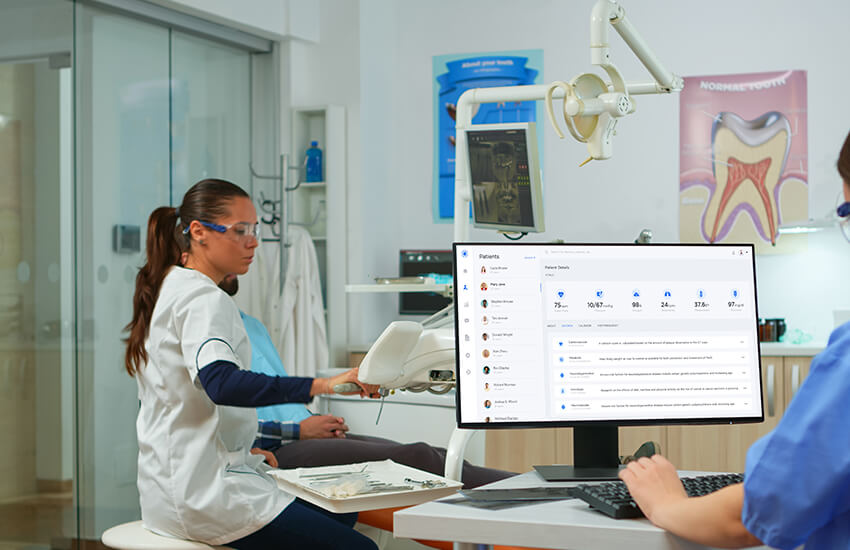
Dentists and dental clinics must deal with a tremendous influx of patients daily and large volumes of patient healthcare data information. As a result, dentists are constantly seeking ways to optimize their workflow and increase their productivity. Dentists are now using dental-specific Electronic Medical Records (EMR) software (also known as Electronic Dental Records (EDR) software). Dental EMR software is specifically developed to streamline the practice’s operations and improve patient care. Dentists and other healthcare practitioners can access a patient’s complete medical history, including allergies, prescriptions, and other important health information, by integrating electronic medical records (EMRs) with dental practice management solutions. This can help them make better clinical decisions and avoid difficulties.
Moreover, EMR integration in dental practice can help boost efficiency and productivity. Dental companies can optimize workflow and decrease administrative stress by automating appointment scheduling, billing, and claims processing. And this enables providers to spend more time with patients and concentrate on providing high-quality treatment. Besides, EMR integration can also assist dental clinics in meeting regulatory requirements such as HIPAA privacy and security regulations. By storing patient information in a secure, electronic system, practices can better protect patient privacy and guarantee that sensitive information is only available to authorized staff.
Furthermore, integrating EMR with dental practice solutions offers multiple benefits. Here are some of the key benefits of the same.
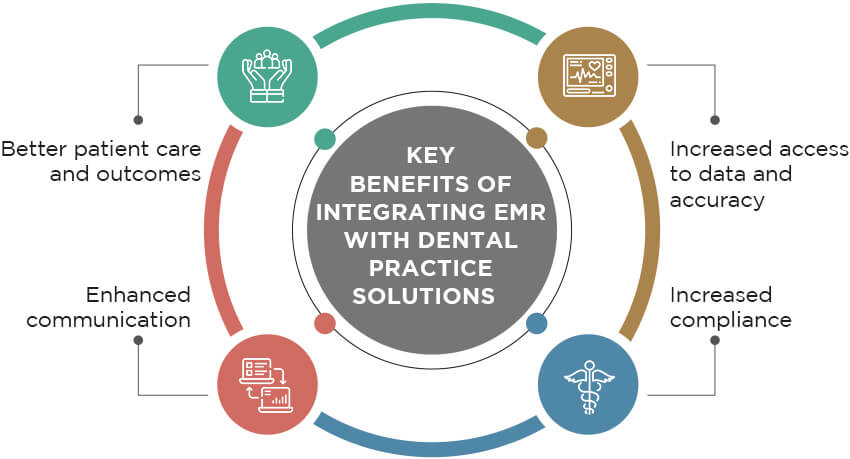
A. Better patient care and outcomes: Dentists and other healthcare practitioners can access a patient’s complete medical history, including allergies, prescriptions, and other important health information, through EMR/EHR integration with the dental practice software. This can assist oral care providers in making more informed care decisions, avoiding potential complications, and providing better care overall.
B. Increased access to data and accuracy: By minimizing errors related to manual data entry, dental EMR-integrated solutions can greatly enhance data accuracy. Patient data can be automatically captured and updated across several systems and modules with EMR connectivity. This minimizes the need for repetitive data entry. Moreover, this can also help reduce errors and provide more accurate and complete patient records. Better data accuracy can result in better patient outcomes, more efficient workflows, and lower liability concerns for dentistry clinics. Furthermore, with more precise data, dental clinics may make better judgments and give better care to their patients.
C. Increased compliance: Integrating EMR or EHR in dental software solutions can considerably improve compliance with regulatory requirements in dentistry clinics. Practices can protect patient privacy and prevent unauthorized access to sensitive information by keeping patient data in a secure digital system. Besides, EMR integration can also help dental clinics comply with healthcare industry laws by making it easier to meet HIPAA privacy and security rules. This can increase patient trust and confidence, enhancing the practice’s reputation in the long run.
D. Enhanced communication: EMR integration with dental solutions can help dental staff, orthodontists, and patients communicate more effectively and easily. Dental care providers can readily access and exchange patient information, improving collaboration and care coordination.
6. Hospice/Home Health
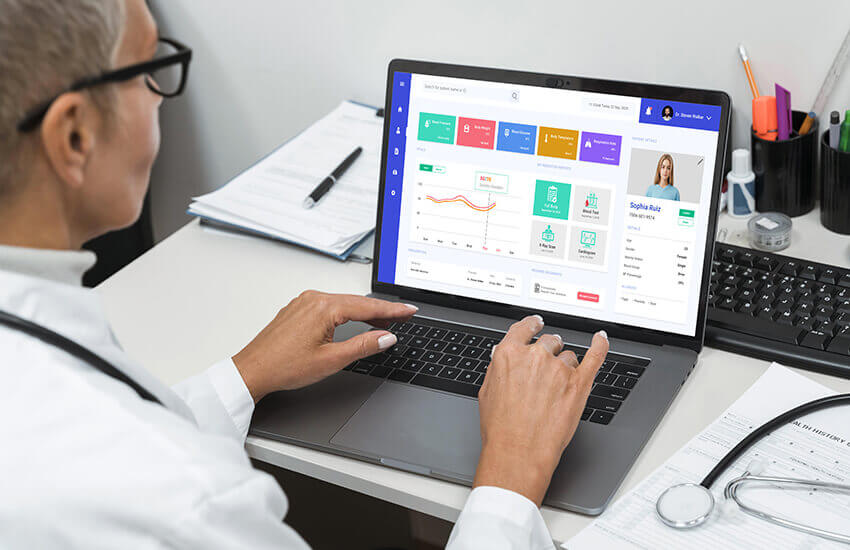
Home health and hospice agencies that digitize their patient records have increased efficiency and productivity, improving patient outcomes. Evolving technology now allows for digitalizing many parts of a patient’s healthcare experience that can be accessed anytime and anywhere. Moreover, this allows for a smooth transition of care and seamless communication between physicians and caretakers, as well as between hospice or palliative organizations, as needed.
In other words, it’s critical that in-home health and hospice use technology to simplify and streamline operations, which will, as previously mentioned, facilitate better and more flexible communication and boost care service delivery. Moreover, the agency will be able to manage data and documents from anywhere by integrating a secure document and data management solution, more precisely, EMR systems for hospice, as well as use other important technologies such as OCR, barcoding, retrieval, and e-forms to optimize care delivery and coordination. Furthermore, caregivers in hospices and home health care centers are continually on the go, as they have to provide care in a patient’s home or an alternative private setting. Having a simple and easy system for them to get data assists them in providing a high level of care. It eliminates roadblocks that could allow your agency to provide optimal care. This is why hospice EMR application is necessary to ensure the proper rendering of care services and better outcomes. Besides, such an integrated solution offers multiple benefits too.
Some of the key benefits of Hospice EMR solutions include-
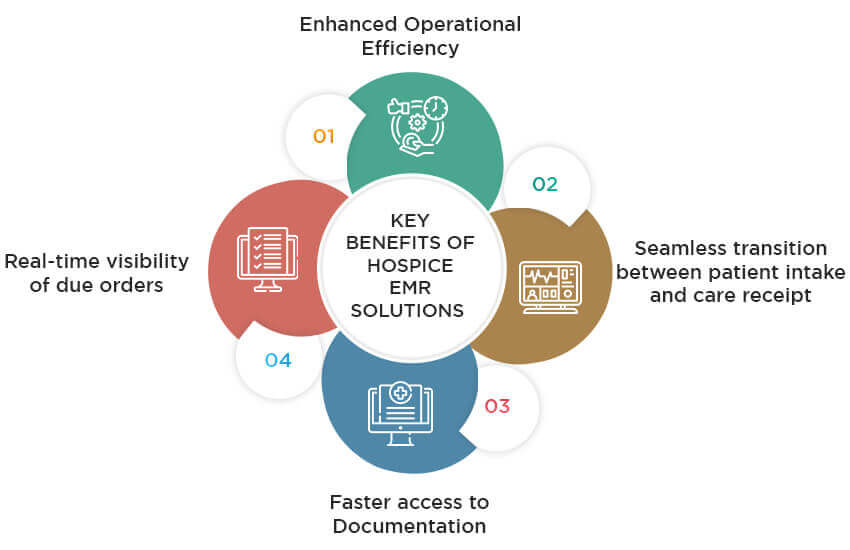
A. Enhanced Operational Efficiency: EMR hospice solutions allow you to consolidate patient files. Caregivers have access to all patient records in one location. They no longer have to waste time looking for records or contacting hospitals to obtain patient medical records. Users can also utilize these systems to automate activities such as arranging follow-up appointments, lab tests, and diagnostic imaging. Furthermore, they aid in the reduction of errors that result in insurance claim denials.
B. Seamless transition between patient intake and care receipt: Hospice EMR software promotes more efficient care coordination. The care team will have faster access to patient charts and medical records than if they had to pull numerous charts. They also get one-stop access to all patient data, including a complete medical history. While the care team will still need to meet with patients at intake, they may better understand potential medication interactions and other diagnostic information that can assist them in developing a care plan and ensure much faster delivery.
C. Faster access to Documentation: Hospice staff can easily upload and access care papers with an integrated EMR system. They can take notes, document wounds, and provide other essential information about each patient. Other care team members can access these notes through mobile devices and from anywhere. This enables them to be sure that patients receive consistent care even when the team switches shifts. Each team member can detect changes in patient’s health conditions, allowing them to provide a consistent experience.
D. Real-time visibility of due orders: Hospice care is time-sensitive, and any lapses in patient care can have long-term consequences. Hospice caregivers can effortlessly handle outstanding orders and forms for anything, from referrals to prescriptions, with a robust EMR hospice system and integrated document management solution. With such real-time visibility, hospice care providers can boost revenue and improve patient outcomes.
7. Clinical Trial Management System
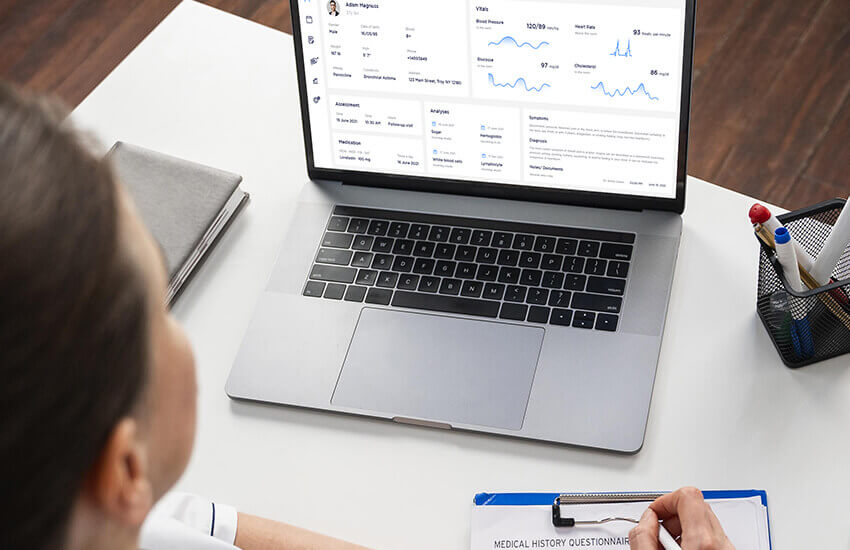
Clinical Trials Management System (CTMS) integrated with an EMR can help biotech and pharmaceutical companies to modernize their operations. These systems typically keep track of a patient’s clinical trial enrollment information. Their medical history must be understood before enrolling in such trials to guarantee optimal patient safety. The integration of CTMS and EMR enables holistic access to patient records for maximum accuracy. Suppose a patient is enrolled in a clinical trial and goes to a hospital for an emergency health condition. In that case, the physician should know that the patient is enrolled in a clinical trial. So, when a CTMS and EMR are integrated, the CTMS can convey information directly to the physician and permits the patient to be flagged as a clinical research participant within the EMR.
It is also difficult to communicate and accurately route costs when using disparate systems that require manual data entry. This can result in clinical research billing problems and even compliance concerns. However, information such as charge determinations and more is automatically transferred from a CTMS to an EMR when systems are seamlessly integrated. This can significantly lower an organization’s risk of noncompliance. Moreover, with the automation of communication of vital information, staff spend less time manually entering data into each system. This ensures data quality and consistency while also alleviating staff workflows. All in all, CTMS and EMR integration can give numerous benefits to both patients and employees, as well as improve overall healthcare quality.
Some of these benefits are-
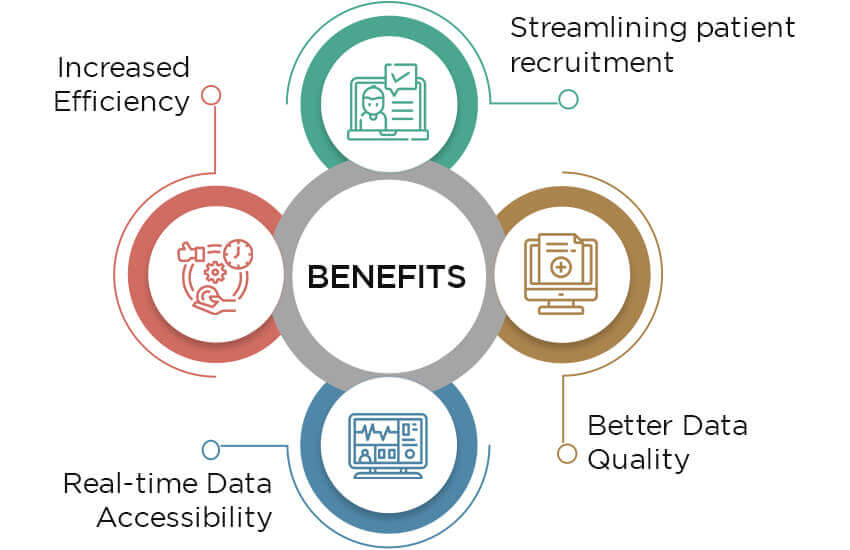
A. Streamlining patient recruitment: By leveraging data analysis, integrating EMRs and CTMS can help identify and enroll eligible patients for clinical trials. This also decreases the time and cost associated with traditional patient recruitment approaches. Moreover, this technique can even speed up the identification process, making it much faster than the conventional method. By boosting the pool of eligible volunteers, this streamlined recruiting method can, in turn, accelerate the trial or clinical study and improve its odds of its success.
B. Better Data Quality: Another benefit to look out for is improvement in data quality. Integrating EHR/EMR applications and CTMS can improve data quality by lowering the likelihood of mistakes and inconsistencies in patient data. The interface enables real-time access to patient data, ensuring that the information captured is complete and current. And this decreases the possibility of duplicate data entry and inaccuracies caused by manual data entry. So, accurate and complete data can increase the quality of research outputs by making it simpler for clinicians to spot trends, patterns, and potential concerns affecting patient care. By providing trustworthy data, healthcare providers and researchers can make better and more informed decisions, resulting in better patient outcomes.
C. Real-time Data Accessibility: Apart from better data quality, integrating EMRs and CTMS can give healthcare practitioners and researchers real-time access to patient data. It allows them to make rapid decisions about patient treatment. Moreover, using real-time data, researchers can swiftly identify concerns and make informed judgments about patient treatment. This can increase patient safety by lowering the possibility of treatment errors or delays.
D. Increased Efficiency: Integrating EMR and CTMS systems to increase efficiency can lessen the administrative burden of managing clinical trials. Automated data entry saves time and resources necessary for human data entry due to integrating electronic medical records and decision support systems. As a result, it minimizes the need for repeat data entry while lowering the risk of error associated with human data entry. Researchers can also concentrate on more important duties, such as data analysis and making informed analyses about patient care.
8. Medical Billing
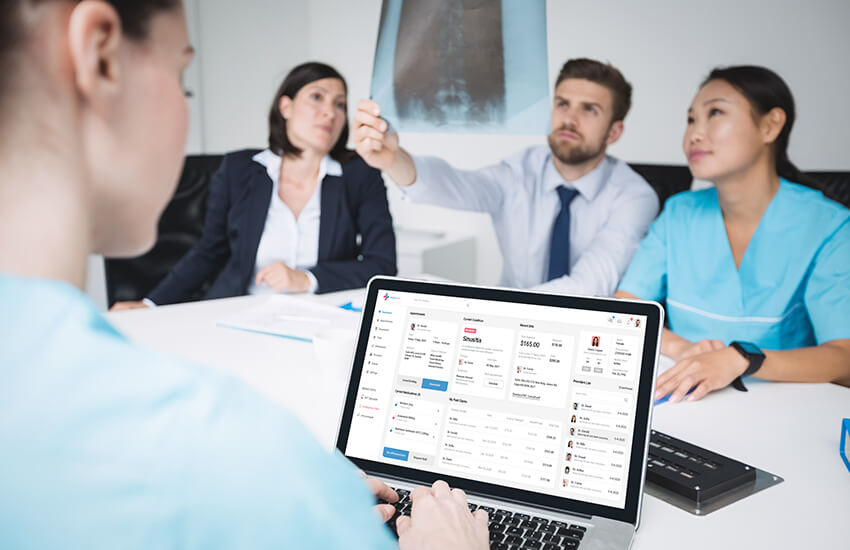
EMR in medical billing is a digital chart that comprises patient information such as past medical history, allergy-related conditions, demographics, immunization dates, medications, physician’s notes, treatment history, diagnoses, and health goals. The EMR medical billing software not only streamlines the digitization process of the healthcare organization but also improves the efficiency and quality of medical care.
Besides, integrating EMR software or EHR applications in medical billing software guarantees that data flows smoothly and without duplication. This integration is a complex process. However, transferring demographics, charges, and patient encounters via HL7 interfaces is possible. An electronic health records software seamlessly connected with a practice management system is another choice for healthcare setups. This will allow practitioners to perform everyday financial and administrative activities more quickly, including coding patient encounters, billing payers, and scheduling appointments. Moreover, integrating EMR or EHR in medical billing solutions offers multiple benefits.
Some of the key benefits of this EMR integration with medical billing applications are:

A. Minimum claims denial: Medical billing software integration with EMRs guarantees accurate and thorough patient care documentation. This lowers the possibility of medical billing problems such as improper coding, incorrect billing information, or missing documentation. As a result, healthcare institutions can drastically minimize the number of denied claims initiated by payer companies. While this saves time and effort, it also ensures that healthcare organizations are properly reimbursed for their services.
B. Enhanced Interoperability: Integrating electronic medical record systems with medical billing software makes electronic data interchange more efficient and productive. This enables the seamless and unhindered flow of information from providers’ systems to payers. It also enables healthcare organizations to readily communicate patient information such as medical history, diagnosis, and therapies with other clinicians involved in the patient’s care. Such a smooth flow of information, or interoperability, can lead to greater care coordination, fewer errors, and better patient outcomes.
C. Improved Reporting: Healthcare providers can develop and personalize various reports based on patient data by integrating EMR/EHR in medical billing, including financial reports and quality reports. Medical billing software may provide complete and accurate reports by merging data from the patient’s medical history and billing information. And doing so enables healthcare companies to make informed decisions about patient care and financial operations. This can assist them in identifying areas for improvement, tracking their progress, and improving the overall quality of patient care.
D. Better Relationship with Patients: Integrating electronic medical records applications with medical billing software enables healthcare practices to improve patient engagement and service. Portals allow patients to access their medical records, billing information, and appointment schedules. And this ensures transparency, trust, and seamless communication between care providers and patients’ relationship. Besides this, the portal allows patients to pay their bills and update their insurance information easily. Furthermore, EMR and EHR-integrated medical billing solutions can automate appointment reminders and follow-up communications, improving patient retention and satisfaction.
Conclusion
In a healthcare setting, provider-patient communications need to be streamlined. That is why EMR integrations are critical. Connecting a patient’s electronic medical record to various third-party systems and applications can significantly improve hospital or clinical productivity. It can improve the patient’s experience by making data flow seamlessly, care service delivery efficient, and several manual tasks digital. Integrating EMR software with other healthcare solutions and services has altered healthcare practices by boosting patient care accuracy, efficiency, and quality. Even the EMR software allows healthcare providers to effectively handle patient data, resulting in fewer errors, increased communication, and better coordination among providers. Healthcare providers can access patient data in real-time by connecting EMR software with other healthcare solutions and services. This allows them to make better, more informed care decisions regardless of patient location. The continuous flow of information between the EMR and other healthcare systems ensures that patient data is accurate and up to date, improving the quality of care offered.
Besides, EMR integration may be challenging and can only be accomplished partially through APIs. However, as EMR adoption approaches saturation, EHR and EMR integration is the next obvious step for healthcare providers looking to connect the dots across diverse systems. Both healthcare providers and software vendors must succeed. Further, bidirectional data flow is required, but EMR integration is much more than that. EMR integration is designed to combine the clinical process and the data flow. It’s very important in terms of scalability. Other roadblocks may develop include unique IDs, data standards, high expenses, privacy, and security concerns. So, if you want to build a connected and robust healthcare management system and ensure continuous data flow in your organization, make a plan to ensure the EMR integration process is smooth and seamless.
References
- https://www.healthcareittoday.com/2023/01/17/where-are-ehrs-headed-in-2023/
- https://blogs.emorphis.com/ehr-and-emr-integration-for-your-healthcare-organization/#EHR_and_EMR_Integration
- https://www.selecthub.com/medical-software/emr/emr-integration/#2
- https://www.healthrecoverysolutions.com/blog/electronic-medical-records-and-telemedicine-software
- https://insights.daffodilsw.com/blog/how-third-party-emr-integration-improves-patient-outcomes
- https://www.welchallyn.com/content/welchallyn/americas/en/education-and-research/research-articles/Four-Tips-for-a-Successful-EMR-and-Device-Integration.html
- https://www.modmed.com/resources/blog/what-to-look-for-in-ophthalmology-ehr-software
- https://www.gohealthcarellc.com/blog/top-considerations-for-choosing-the-best-dental-clinic-emr-software
- https://digitalhealth.folio3.com/blog/emr-in-medical-billing/#FAQs
- https://www.enter.health/post/emr-integration-a-brief-overview#:~:text=Electronic%20Medical%20Record%20(EMR%20integration,patient’s%20records%20from%20any%20location.
OSP is a trusted software development company that delivers bespoke solutions as per your business needs. Connect with us to hire the best talents in the industry to build enterprise-grade software.

How can we help?
Fill out the short form below or call us at (888) 846-5382
Looking for software solutions to build your product?
Let's discuss your software solutions for your product in our free development acceleration call!
Get In Touch arrow_forwardDiscuss Your Project Handover with a team of expert Book a free consultation arrow_forward
About Author

Written by Riken Shah linkedin
Riken's work motto is to help healthcare providers use technological advancements to make healthcare easily accessible to all stakeholders, from providers to patients. Under his leadership and guidance, OSP Labs has successfully developed over 600 customized software solutions for 200+ healthcare clients across continents.

















